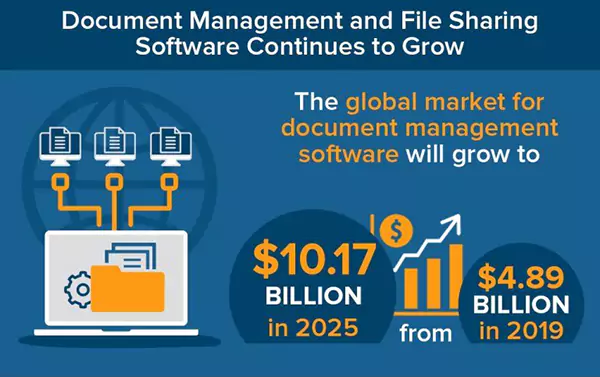Compliance and Governance in Enterprise Document Management
Jump To Key Section

It’s 2024 and businesses are evolving at a pretty fast speed.
The world is living in a pretty digital space now where data is like the bread and butter for any organization.
This is why we need a system to keep up with the compliance and governance of the document processing needs of today.
This is where enterprise document management comes in and enterprise document management systems help us manage sensitive data within the company.
Well, in this blog, we will get into the complexities of EDMS and how businesses can set up regulatory practices to make sure that their document processing is done in a secure, ethical, and efficient setting.
So, What Exactly is Enterprise Document Management?
It is a way to keep track of a company’s paper and electronic documents. Also, learn about How Construction Management Software Transforms Project Management with this guide.
So, if they are ever needed in the future (like for a compliance audit or a subpoena), they can be accessed very easily.
DID YOU KNOW?
An enterprise document management system allows users to create, store, manage, index, protect, retrieve, and even organize different kinds of documents online.
Understanding Compliance in Enterprise Document Management System
In the beginning, compliance with the EDMS would only refer to digitally created documents or documents that were scanned and ported to digital format.
But with time, its use broadened to include images, emails, chat transcripts, and more.
So, when we talk about regulatory compliance, enterprise document management covers the following:
- How much time does a business need to keep a document?
- Where does it store those documents?
- How can they find the documents when needed?
- How do they recover the documents in case of a disaster or emergency?
All these regulations change depending on the industry, the location, and the type of information.
Common compliance areas include data privacy laws, industry-specific regulations, and international standards for information security.
Benefits of Compliance in EDMS
- Risk Mitigation: It involves setting up strong compliance systems in place to lower the chance of any legal issues due to poor management or failure to abide by pertinent regulations.
- Data Protection: It can also help protect the company from data breaches that could potentially harm the reputation of the company and lose the customer’s trust.
- Operational Efficiency: By following standardized processes mandated by compliance regulations, businesses may enhance their operational efficiency in document management.
Governance: A Framework for EDMS
For EDMS, governance is the framework of all the processes, policies, and controls that can fit in with the company’s goals and values.
It covers the full lifecycle of the document, from creation to disposal, and aims to give us a better way to approach decision-making, accountability, and transparency.
Key Components of Governance in EDMS
- Document Lifecycle Management: The framework gives us a guideline to create, sort, store, pull, and dispose of our documents. This helps make sure that consistency and compliance at every stage.
- Access Controls: It also defines who has access to what information within the EDMS. This means that any sensitive documents are restricted to authorized personnel only.
- Version Control: It also includes version control to track document changes over time, keeping the document pretty much in its original state.
- Audit Trails: Audit trails that log user activities give us a comprehensive record for compliance purposes and internal monitoring.
- Training and Awareness: To ensure practical EDMS usage, governance emphasizes training programs and awareness initiatives, informing users about compliance requirements and best practices.
Challenges in Compliance and Governance
While governance and compliance with EDMS are important, it can be pretty hard for companies to implement and maintain the systems in place.
- Data Proliferation: The amount of data that is generated is pretty huge. Maintaining it or keeping up with compliance across all documents can be a lot of work too.
- User Resistance: Employees may resist new governance policies, highlighting the need for comprehensive training and change management strategies.
- Cross-Border Data Transfers: With so many companies going global, many oftentimes find it hard to do cross-border data transfers, especially when there are strict data protection laws in place.
- Evolving Regulatory Landscape: Regulatory laws change. And pretty frequently at that. Keeping up with regulatory changes, updates, and new compliance requirements requires you to be on top of it constantly. Plus, there is a greater risk of noncompliance and fines if you fail.
- Balancing Compliance with Innovation: Finding a balance between compliance and innovation can be a challenge. While compliance measures are necessary for data protection and ethical document management, organizations must also foster an environment that encourages innovation.
Selecting the Right EDMS for Compliance and Governance
Choosing the right EDMS is climactic for organizations aiming to strengthen their compliance and governance practices.
Key Features to Look for:
- Security Measures: Having strong security protocols like encryption, including encryption, access controls, and authentication protocols, is very important for compliance with data protection regulations.
- Comprehensive Audit Trails: An EDMS with detailed audit trails encourages compliance reporting and internal monitoring, helping businesses meet the standard regulatory requirements.
- Automated Workflows: Automation simplifies document processes, lowering the risk of human error and sticking to policies.
- User-Friendly Interface: A user-friendly interface improves adoption and compliance, as employees are more likely to stick to policies when the system is intuitive and easy to use.
- Scalability: If you’ve chosen an EDMS, it needs to be scalable to keep up with the company’s growing needs without compromising compliance and governance standards.

The worldwide market for document management software was valued at $4.89 billion USD in 2019. It is projected to reach $10.17 billion by 2025. The file-sharing market size is projected to reach $9.9 billion by 2023.
Conclusion
If your company is looking for a secure and ethical way to approach document filing, then governance and compliance in an enterprise document management system are very important.
By learning and fixing the issues in compliance and governance, businesses can create a strong framework that helps them stick to regulations and improve their efficiency and data protection.
The careful selection of an EDMS with the right features further cements the foundation for a secure future where documents are managed with integrity, accessibility, and compliance at the vanguard.








